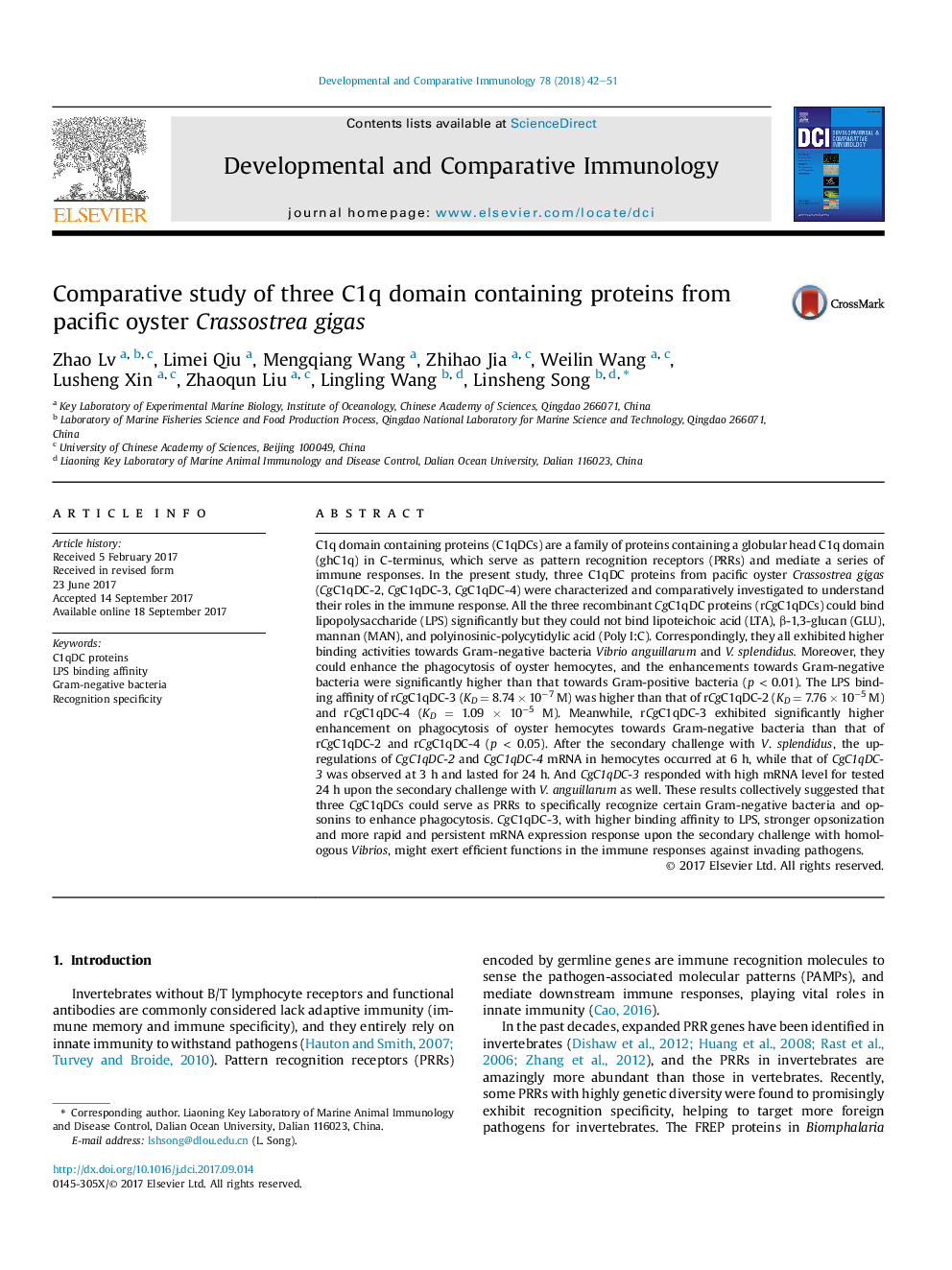| کد مقاله | کد نشریه | سال انتشار | مقاله انگلیسی | نسخه تمام متن |
|---|---|---|---|---|
| 5539915 | 1553554 | 2018 | 10 صفحه PDF | دانلود رایگان |
عنوان انگلیسی مقاله ISI
Comparative study of three C1q domain containing proteins from pacific oyster Crassostrea gigas
دانلود مقاله + سفارش ترجمه
دانلود مقاله ISI انگلیسی
رایگان برای ایرانیان
کلمات کلیدی
موضوعات مرتبط
علوم زیستی و بیوفناوری
بیوشیمی، ژنتیک و زیست شناسی مولکولی
زیست شناسی تکاملی
پیش نمایش صفحه اول مقاله

چکیده انگلیسی
C1q domain containing proteins (C1qDCs) are a family of proteins containing a globular head C1q domain (ghC1q) in C-terminus, which serve as pattern recognition receptors (PRRs) and mediate a series of immune responses. In the present study, three C1qDC proteins from pacific oyster Crassostrea gigas (CgC1qDC-2, CgC1qDC-3, CgC1qDC-4) were characterized and comparatively investigated to understand their roles in the immune response. All the three recombinant CgC1qDC proteins (rCgC1qDCs) could bind lipopolysaccharide (LPS) significantly but they could not bind lipoteichoic acid (LTA), β-1,3-glucan (GLU), mannan (MAN), and polyinosinic-polycytidylic acid (Poly I:C). Correspondingly, they all exhibited higher binding activities towards Gram-negative bacteria Vibrio anguillarum and V. splendidus. Moreover, they could enhance the phagocytosis of oyster hemocytes, and the enhancements towards Gram-negative bacteria were significantly higher than that towards Gram-positive bacteria (p < 0.01). The LPS binding affinity of rCgC1qDC-3 (KD = 8.74 à 10â7 M) was higher than that of rCgC1qDC-2 (KD = 7.76 à 10â5 M) and rCgC1qDC-4 (KD = 1.09 à 10â5 M). Meanwhile, rCgC1qDC-3 exhibited significantly higher enhancement on phagocytosis of oyster hemocytes towards Gram-negative bacteria than that of rCgC1qDC-2 and rCgC1qDC-4 (p < 0.05). After the secondary challenge with V. splendidus, the up-regulations of CgC1qDC-2 and CgC1qDC-4 mRNA in hemocytes occurred at 6 h, while that of CgC1qDC-3 was observed at 3 h and lasted for 24 h. And CgC1qDC-3 responded with high mRNA level for tested 24 h upon the secondary challenge with V. anguillarum as well. These results collectively suggested that three CgC1qDCs could serve as PRRs to specifically recognize certain Gram-negative bacteria and opsonins to enhance phagocytosis. CgC1qDC-3, with higher binding affinity to LPS, stronger opsonization and more rapid and persistent mRNA expression response upon the secondary challenge with homologous Vibrios, might exert efficient functions in the immune responses against invading pathogens.
ناشر
Database: Elsevier - ScienceDirect (ساینس دایرکت)
Journal: Developmental & Comparative Immunology - Volume 78, January 2018, Pages 42-51
Journal: Developmental & Comparative Immunology - Volume 78, January 2018, Pages 42-51
نویسندگان
Zhao Lv, Limei Qiu, Mengqiang Wang, Zhihao Jia, Weilin Wang, Lusheng Xin, Zhaoqun Liu, Lingling Wang, Linsheng Song,